|
|
 |
|
Calanoida ( Order ) |
|
|
|
Eucalanoidea ( Superfamily ) |
|
|
|
Eucalanidae ( Family ) |
|
|
|
Eucalanus ( Genus ) |
|
|
| |
Eucalanus inermis Giesbrecht, 1892 (F,M) | |
| | | | | | | Syn.: | Eucalanus elongatus inermis Giesbrecht,1892 (p.149); Sewell, 1948 (p.561, Rem.);
Subeucalanus inermis : Suarez-Morales & Gasca, 1998 a (p.109)
Eucalanus muticus Wilson, 1950 (p.209, figs.F,M), after Fleminger (in Brinton & al., 1986, p.228, Table 1: Rem.) | | | | Ref.: | | | M. W. Johnson, 1938 (p.170, figs.F); Vervoort, 1946 (p.91, Rem.); Brodsky, 1950 (1967) (p.102, figs.F); Mazza, 1967 (p.71, Rem.); Vidal, 1968 (p.20, figs.F,M); Volkov, 1970 a et b (p.355, et p.354: figs.M); Fleminger, 1973 (p.978, 998); Arcos, 1975 (p.11, figs.F); Goetze, 2003 (p.2322 & suiv.); Hidalgo & Escribano, 2006 (p.513, figs. N) | 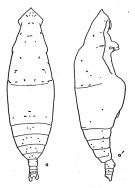 issued from : A. Fleminger in Fishery Bull. natn. Ocean. Atmos. Adm., 1973, 71 (4). [p.989, Fig.13]. Female: a, habitus (dorsal), a', idem (lateral right side).
Dorsal and lateral pattern of integumental organs (black point = sites occuring at 100% frequency, o = 80-99% frequency, x = 10-79% frequency, triangle are sites which are also visible in lateral view but which are assigned to dorsal sets);
|
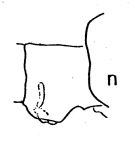 issued from : A. Fleminger in Fishery Bull. natn. Ocean. Atmos. Adm., 1973, 71 (4). [p.968, Fig.1, n (p.969)]. Female (: n, genital segment (lateral right side).
|
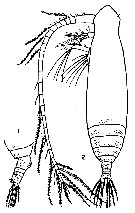 issued from : M.W. Johnson, in Bull. Scripps Instn Oceanogr., 1938, tech. Ser., 4 (6). [p.166, Figs.1, 2]. Female (from 9°23'-23°10'N, 87°30'-110°11'W): 1, posterior portion of body (lateral); 2, habitus (dorsal).
|
 issued from : M.W. Johnson, in Bull. Scripps Instn Oceanogr., 1938, tech. Ser., 4 (6). [p.168, Figs.11, 12, 13, 14, 15, 16]. Female: 11, A2; 12, Mx2; 13, Mxp; 14, Md (mandibular palp); 15, Mx1; 16, P1.
|
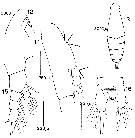 issued from : D.F.R. Arcos in Gayana, Zool., 1975, 32. [Lam.II, Figs.12-16]. Female (from Bahia de Concepcion, Chile): 12, forehead (lateral); 13, habitus (dorsal); 14, basipod segment 2 of Md; 15, P1; 16, posterior portion of urosome (dorsal).
| | | | | Compl. Ref.: | | | Fleminger, 1967 a (tabl.1); Vinogradov, 1968 (1970) (p.79, 277); Björnberg, 1973 (p.297, 386); Fleminger & Hulsemann, 1973 (p.343, carte); Heinrich, 1973 (p.95, fig.4); Judkins, 1980 (p.475, fig.4: vertical distribution vs O2 minimum); Herman & Mitchell, 1981 (p.739, Table 2, length-volume); Herman & Sameoto, 1981 (p.228, Table 1, 2, abundance); Arashkevich & al., 1982 (p.477, Table 2, diet); Van der Spoel & Heyman, 1983 (p.46, fig.58); Herman A.W., 1984 (p.131, Rem.: p.133); Longhurst, 1985 (tab.2); Brinton & al., 1986 (p.228, Table 1, Rem.); Chen Y.-Q., 1986 (p.205, Table 1: abundance %, Table 2: vertical distribution); Jimenez-Perez & Lara-Lara, 1988; Cervantes-Duarte & Hernandez-Trujillo, 1989 (tab.3); Heinrich, 1990 (p.16); Vinogradov & al., 1991 (p.559); Flint & al., 1991 (p.199); Fernandez-Alamo & al., 2000 (p.1139, Appendix); Escribano & Hidalgo, 2000 (p.283, tab.2); Suarez-Morales & al., 2000 (p.751, tab.1); Hidalgo & al., 2005 (p.519, vertical distribution and diel migration vs O2 min.); 2005 a (p.1025, annual life cycle); Escribano, 2006 (p.20, Table 1); Ferrari & Dahms, 2007 (p.64, Rem.: diapause); Morales-Ramirez & Suarez-Morales, 2008 (p.519); Lopez Ibarra, 2008 (p.1, Table 1, 2, figs.11, 16: abundance, Table 3: N, C isotopes, fig. 19, Table 4: index trophic); Ayon & al., 2008 (p.238, Table 4: Peruvian samples); Escribano & al., 2009 (p.1083, Table 1, 2, figs.6, 7, 9, 10); C.E. Morales & al., 2010 (p.158, Table 1); Hidalgo & al., 2010 (p.2089, fig.2, 4, Table 2, cluster analysis); Goetze & Ohman, 2010 (p.2110, Table 1, biogeography); Cass, 2011 (p.1, oxygen consumption, excretion, composition, metabolism, lipids); Tutasi & al., 2011 (p.791, Table 2, abundance distribution vs La Niña event); Hidalgo & al., 2012 (p.134, Table 2); in CalCOFI regional list (MDO, Nov. 2013; M. Ohman, comm. pers.); Wishner & al., 2013 (p.122, vertical distibution); Williams R., 2013 (p.71, figs., Table 3.2, 3.4, 3.6, Appendix A, C; C & N composition, trophic level); Lopez-Ibarra & al., 2014 (p.453, fig.6, Table 2, biogeographical affinity, Rem.: p.460); Jackson & Smith, 2016 (p.305, figs. 3, 4, 5, vertical abundance vs day/night cycle); | | | | NZ: | 4 | | |
|
Distribution map of Eucalanus inermis by geographical zones
|
| | | 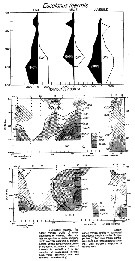 Issued from : Y.-Q. Chen in CalCOFI Rep., 1986, XXVII. [Fig.5, p.213]. Issued from : Y.-Q. Chen in CalCOFI Rep., 1986, XXVII. [Fig.5, p.213].
Vertical abundance of females, males and late copepodites.
Nota: One of the most numerically important species in the cruise from the expedition in the Pacific East tropical (23°N to 3°S).
Its vertical distribution ranged from the surface to the deepest layer sampled (until 800 m).
Adults occurred mainly at 3 stations (17, 18 and 19); thus its principal horizontal distribution extended from 6°N to 11°N with greatest abundances from 300 to 600 m.
Females were more abundant than males, being concentrated mainly from 500 to 800 min the day samples. Adults were less frequent at the surface especially at stations 12, 14, 16, 17 and 20-22 (see chart in Subeucalanus subtenuis fig.1). At stations influenced by the California Current, this species was found at the surface. The distribution of juveniles differed from that of the adults. |
 Issued from : G.A. Lopez Ibarra in Tesis, Inst. Politec. Nac., CICIMAR, 2008. [p.37, Table 3]. Issued from : G.A. Lopez Ibarra in Tesis, Inst. Politec. Nac., CICIMAR, 2008. [p.37, Table 3].
Summary of abundance and steady isotopics 15N and 13C in Subeucalanus subcrassus.
O = main feeding: omnivore; T = tropical biogeographical affinity; zones (a-f) = Cf. fig.1 in the same author.
Compare with Subeucalanus subcrassus and other species (Tabla 3).
Considered also as herbivore: 15N =6.3; 13C = -22.8. |
| | | | Loc: | | | Pacif. (E equatorial), W Baja California, Gulf of California, G. of Tehuantepec, W Mexico, off W Guatemala, Costa Rica Dome, W Costa Rica, Galapagos-Ecuador, SE Pacif. (tropical), off Peruvian coast, Chile (N, off Santiago, Concepcion) | | | | N: | 39 | | | | Lg.: | | | (22) F: 6,2-6; (137) F: 5,65; M: 5,5; (187) F: 6,65-5,53; M: 4,7-4,3; (391) M: 4,7-4,5; (1125) F: 6,0; {F: 5,53-6,65; M: 4,30-5,50} | | | | Rem.: | See remaks Eucalanus elongatus from Vervoort (1963 b, p.88-89)
See Subeucalanus subgrassus the vertical distribution day night by Jackson & Smith (2016, p.310, fig.3 and p.311, fig.4) in the Costa Rica Dome (Eastern tropical Pacific).. | | | Last update : 08/12/2020 | |
|
|
 Any use of this site for a publication will be mentioned with the following reference : Any use of this site for a publication will be mentioned with the following reference :
Razouls C., Desreumaux N., Kouwenberg J. and de Bovée F., 2005-2025. - Biodiversity of Marine Planktonic Copepods (morphology, geographical distribution and biological data). Sorbonne University, CNRS. Available at http://copepodes.obs-banyuls.fr/en [Accessed December 02, 2025] © copyright 2005-2025 Sorbonne University, CNRS
|
|
 |
 |









